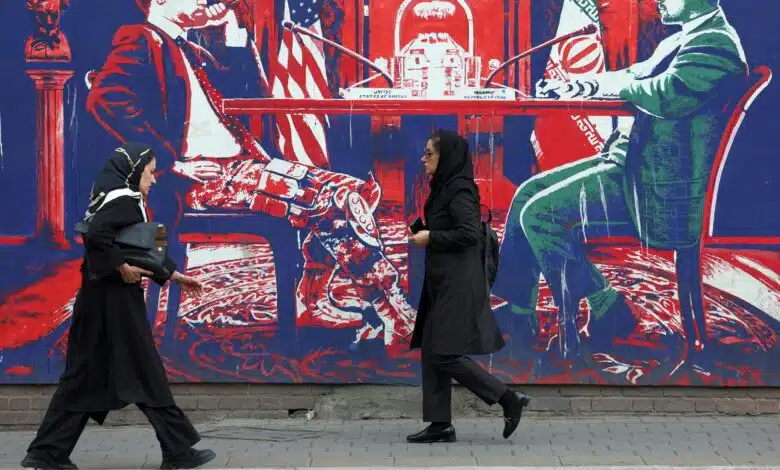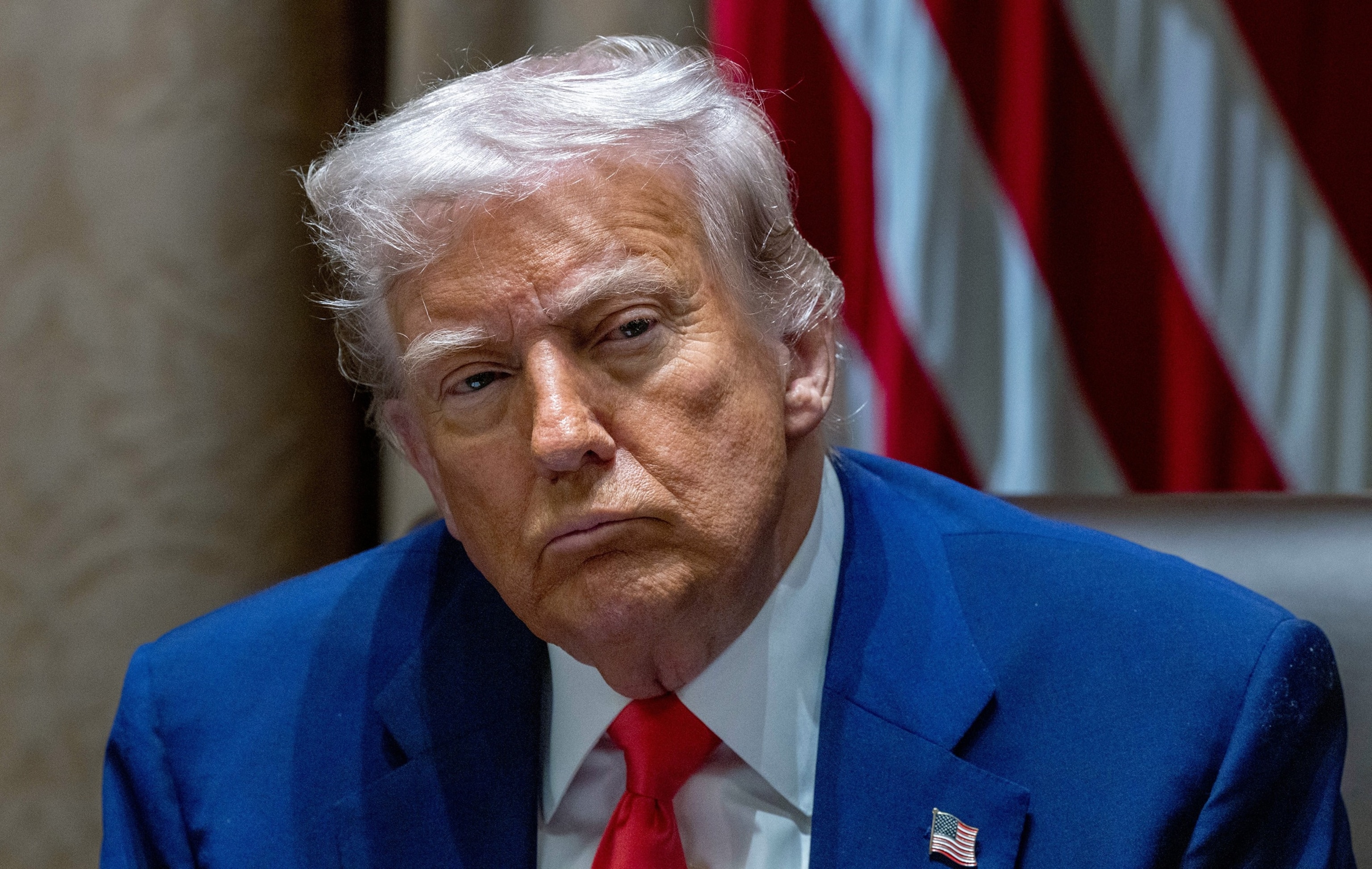United States, Iran holding makeup or rupture conferences: analysis

The high-level delegations of the United States and Iran meet over the weekend in Oman to discuss the fast nuclear nuclear program, holding what the White House dit will be direct conversations for the first time in seven years.
Reunion comes when experts are largely suitable that Iran’s escape time to raise enough fissile equipment to produce a nuclear warhead has decreased to one to two weeks – and that Tehran could produce a nuclear weapon available in less than a year.
Despite the opening of a communication line with Iran, the Trump administration plays Hardball – the president himself indicating repeatedly last week that the alternative option of Iran to conclude an agreement was under military attack, preparing the ground for a diplomatic confrontation with high issues.

The Iranians walk alongside an anti-American wall next to the former US embassy in Tehran, Iran, April 7, 2025.
Abedin Taherkenareh / EPA / Shutterstock
Already aside?
Before the planned meeting, the two parties presented various ideas on how talks would be sweated.
As soon as President Donald Trump made the surprise announcement that his administration would soon join Iran at an oval office meeting with Israeli Prime Minister Benjamin Netanyahu on Monday, he was categorical that the two countries would not count on an intermediary.
“We have direct interviews with Iran, and they started. It will go on Saturday,” Trump said. “We have a very large meeting and we will see what can happen.”
But the officials of Tehran quickly rejected this, the Iranian Minister of Foreign Affairs Abbas Araghchi saying that the meeting of April 12 would be “high -level talks”.
“It is as much an opportunity as a test,” he wrote in an article on social networks on X.

The White House press secretary Karoline Leavitt speaks with journalists in James Brady’s press design room in the White House, April 11, 2025, in Washington.
Alex Brandon / AP
“Well, I spoke both to the president and his national security team who will be engaged in these discussions. These will be direct talks with the Iranians,” the White House press secretary Karoline Leavitt said on Friday.
“The ultimate goal is to ensure that Iran can never get a nuclear weapon. The president believes in diplomacy, direct talks, speaking directly in the same room in order to achieve this goal,” she continued.
If the Vision of the White House is carried out, the talks mark the first time that the delegations of Iran and the United States have met face to face since 2018, when Trump left a nuclear agreement with Iran, the Complete Complete Action Plan (JCPOA), which was negotiated during the Obama administration.
New approaches, imminent deadlines
When it comes to understanding the Trump administration’s strategy, the format of talks may not be as important as the fact that talks should occur in the first place.
Doreen Horschig, a scholarship holder with the project on nuclear issues at the Center for Strategic and International Studies, and Bailey Schiff, program coordinator and research assistant for the program, asserted the president’s approach at Iran has progressed.
“The Iran strategy of the Trump administration has increased from a first-term approach focused on maximum economic pressure to a second mandate strategy that combines diplomacy, military threats and sanctions,” they said, adding that the game plan is now based on “diplomatic awareness, military posture and sustained economic pressure”.

The Iranian Minister of Foreign Affairs, Abbas Araghchi, attended a joint press conference with his Armenian counterpart after their talks in Yerevan, Armenia, March 25, 2025.
Karen Minasyan / AFP via Getty Images
“What matters is that they speak,” wrote Trita Parsi, executive vice-president of the Quincy Institute for Responsible Statecraft, in an Op-Ed for Time magazine.
Parsi also argued that timing is essential for Iran and the United States
“Despite his aggressive speech and his military posture, Trump cannot afford another major war in the Middle East,” he said. “He has long been a candidate who promises to bring the troops back to the house – not to tangle them into a new war.”
Meanwhile, Parsi noted that Iran was against a potential worsening of economic perspectives.
Already limited by in -depth American sanctions, Tehran must also face the “Snapback mechanism” of the JCPOA – a kind of emergency brake integrated into the agreement which allows the United Nations sanctions to be automatically repaired if Iran violates the terms of the agreement.
European countries which have always gone to the JCPOA have until October 18 to trigger the Snapback function of the agreement and seem to be more and more motivated to do so before the deadline.
But given the accelerated nuclear calendar of Iran, the United States – and other countries that do not want to see a nuclear compatible teheran – also feel a crunch.
For the moment, there is no indication that the Iranian regime has given orders to go to the higher level when it comes to developing a nuclear warhead, but many American officials estimate that it is subject to increasing pressure to do it carnaces due to threats perceived for the security of Iran and wider disorders in the Middle East.
Carrots and sticks
Despite the desire to engage in the Trump administration and the economic pressure pushing the Iranian regime, negotiators may find it difficult to design an agreement which can encourage all parties, according to the former American ambassador of Israel Daniel B. Shapiro, a distinguished scholarship holder with the Midle’s Security Initiative of the Atlantic Council.
“If and when the talks become serious, the two parties will face significant shortcomings,” said Shapiro, former deputy deputy secretary for the Defense for the Middle East and principal advisor to the Bureau of the Middle East of the State Department.

President Donald J. Trump listens to the remarks at a meeting from the Cabinet to the White House in Washington on April 10, 2025.
Shawn Thew / Epa-Efe / Shutterstock
Shapiro noted that Trump, like the Biden administration before him, is looking for a stronger agreement than the JCPOA.
“His objectives include the dismantling of the Tehran nuclear program,” said Shapiro. “Based on all Iranian behavior in previous negotiations, there is no reason to believe that Tehran would accept these conditions.”
Even if Iran had conceded, Shapiro argued that Tehran would likely expect a massive relief of the sanction – something that Congress probably does not inspire.
Trump said that if an agreement cannot be concluded, military action combined with Israel against Iran is the next option.
“If it requires soldiers, we are going to have soldiers,” Trump said on Wednesday. “Israel will obviously be very involved in this. They will be the leader of this.”
“He and his team surely know that within a relatively short time, he is likely to face the point of decision on the opportunity to continue a military strike or not,” said Shapiro. “Timing, need and opportunity may never be more convincing.”





